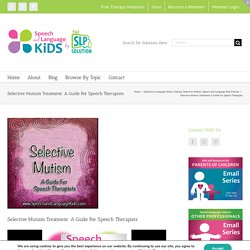

These resources explain why students with SM do not speak at school and how others can help. What Is Selective Mutism? Understanding Selective Mutism TED Talk. Selective Mutism is More Than Just Shyness! What is Fear? What is Anxiety? Selective Mutism Explained (for younger children) Selective Mutism Explained (for older children) Meet the Cat Helping a Boy with Selective Mutism! A Teacher's Guide to Selective Mutism. If you learn that a new student in your class has struggled with selective mutism in the past, helping him learn to feel comfortable with you is important.

Here are some ideas that might help: Schedule a Visit Many experts recommend that a student with SM meet his new teacher before school starts so that he gets to have a one-on-one interaction, before other kids are around. You could arrange for the child’s parents to bring him by the classroom in the days before school starts so that you could introduce yourself and give a tour of the classroom. He doesn’t need to speak to you during this first meeting if he isn’t ready, but he might be able to have a conversation with his parents so that he starts building successful speaking experiences inside the classroom. If there are toys in the classroom, you might give him the chance to play for a few minutes. Make a Video Another good way to break the ice is to have the child record a short video for you at home. What Teachers Need to Know About Selective Mutism. Most teachers would give anything for a few quiet minutes in the classroom, but one teacher on the WeAreTeachers HELPLINE Facebook group is facing a different problem this year.

“I have a little girl who spoke maybe four words all last year while in kindergarten and now that she’s in first grade is not yet talking,” this teacher shared. “She talks to her friends. She talks to her family. Once she almost talked to me, half accidentally. Selective Mutism Tips for Teachers. SM Recommendations for Teachers. FAQ for Educators. Understanding and Managing Selective Mutism. Classroom Strategies. Ideas for Keyworkers. School Psyched Podcast. Outloud The Selective Mutism Podcast. Printable Communication Cards! Maya's Voice - Book for Class Lesson. Lesson Plan for Maya's Voice Reading. Selective Mutism Webinar. CE/CME Information Physicians In support of improving patient care, this activity has been planned and implemented by Amedco LLC and Anxiety and Depression Association of America (ADAA).

Amedco LLC is jointly accredited by the Accreditation Council for Continuing Medical Education (ACCME), the Accreditation Council for Pharmacy Education (ACPE), and the American Nurses Credentialing Center (ANCC), to provide continuing education for the healthcare team. Credit Designation Statement – Amedco LLC designates this live activity for a maximum of 1.0 AMA PRA Category 1 CreditsTM. Physicians should claim only the credit commensurate with the extent of their participation in the activity.
Psychologists This course is co-sponsored by Amedco and Anxiety and Depression Association of America (ADAA). NBCCThe Anxiety and Depression Association of American (ADAA) has been approved by NBCC as an Approved Continuing Education Provider, ACEP No. 6872. Selective Mutism University - FREE course. Braving COVID-19: Therapeutic Ideas to Continue Support. Amidst school closures and home quarantines, it has become more difficult (but not impossible!)

To support children struggling with selective mutism and/or social anxiety with their brave talking goals. We are sharing some ideas for maintaining continuity of treatment goals and progress given the current COVID-19 health crisis. Some of these suggestions may be standalone while others may require therapeutic support. With the help of technology, youth can continue to work on speaking goals through video exposures/bravery practices. Schedule video sessions (using Google Meet, Facetime, Zoom, Houseparty, Facebook Messenger, etc.) with preferred peers, family members, and others in your child’s social network (e.g., classmates, teachers, coaches).
Clinical Treatment Approaches. SMA Educator ToolKit. DOs & DON’Ts for Interaction. Suggested Games and Activities to Complete with Relatives & Friends!

Show off school work, drawings, photo albums, etc. where the relative can ask direct/choice questions regarding the ‘prop’ shownGames: board games, card games (Go Fish, War), complete back/forth interview gamesJokes & RiddlesTreasure Hunts/Eye SpyPuppetsArt ProjectsHelping around the house, cooking/baking During these games and activities, relatives, friends, or school staff should ask the child questions.
It is how these questions are asked that will make the difference. For example, if the individual is typically mute with someone, but becoming nonverbal, using a parent, sibling, or someone else he or she is verbal with as a Verbal Intermediary® is suggested. As the individual responds by telling his or her Verbal Intermediary®, the relative should repeat what was said. As a physician, Dr. "The Spot" - a safe, predictable place in the school.
Exposure Therapy: Brave Chart! When a person is fearful of something, they tend to avoid it.

The more they avoid it, the more the fear grows. Exposing a person to the thing they fear in a safe, supportive way helps them to break this cycle and become less fearful and avoidant. This type of treatment, called exposure therapy, can be effective in many types of anxiety disorders, including selective mutism. The goal of exposure therapy in selective mutism is to help the child take small, consistent steps to face their fear of speaking without overwhelming them.
They are not thrown into a scary situation, rather supported while they gradually take one step at a time toward the anxiety-provoking situation. Printable Brave Chart! 504 Plan Suggestions. Treatment Guide For Speech Therapists. What is Selective Mutism?

Selective mutism is a diagnosis that describes a child who does not speak in certain situations where speech is expected (such as at school or in public) but is able to speak normally in at least one other setting (such as at home). According to the Diagnostic And Statistical Manual (DSM-V), this impairment must be interfering with the child’s education or occupational achievement or be impacting his/her social communication in order for the child to qualify for the “Selective Mutism” diagnosis. The child must also have been experiencing the selective mutism for at least one month, cannot be due to a lack of knowledge or comfort with the language in use, and cannot be better explained by some other communication disorder (ex. stuttering). Keep in mind that this is much more severe than the typical “shy” child. SLP Trends and Tactics Presentation.